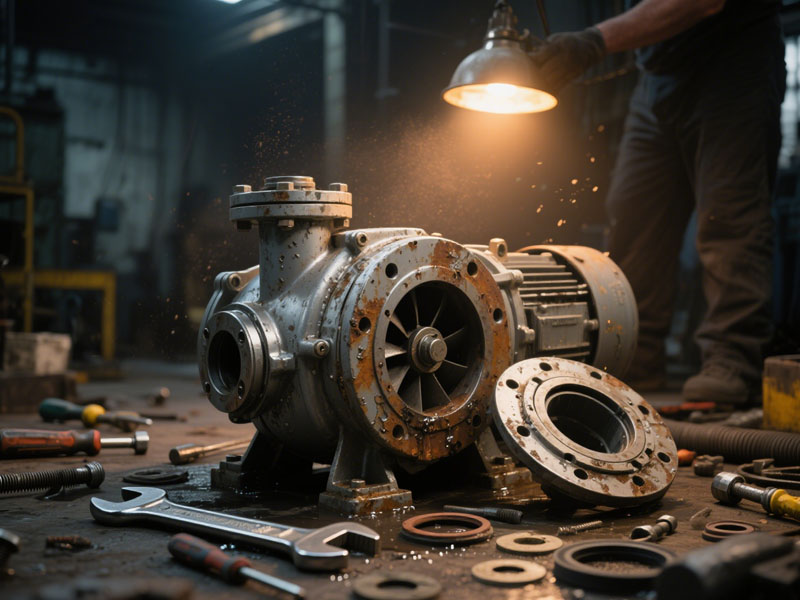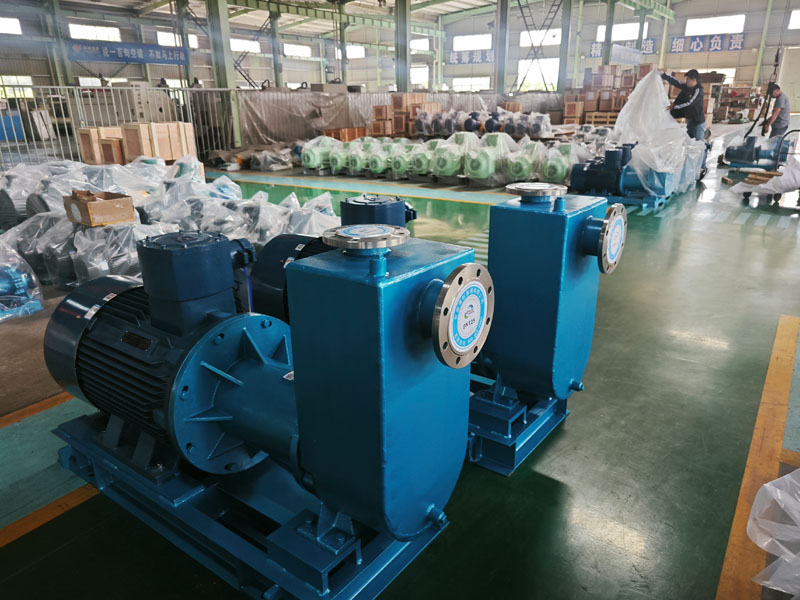Common 9 Faults and Solutions for Self-Priming Pumps
Today's news is about answering common questions regarding self-priming pumps. If you have any needs for such pumps, you can also inquire about pricing from Anhui Shengshi Datang. We also offer other pumps like magnetic pumps and centrifugal pumps, providing you with the most competitive prices.
A self-priming pump is a type of centrifugal pump with a certain gas extraction capability under suction conditions. It primarily combines the gas-liquid mixing principle with the pump's unique structure to extract gas, achieving a certain level of vacuum in the pump's suction pipeline, thereby enabling centrifugal functionality.

Below are the common faults and solutions for self-priming pumps.
1. Excessive Noise from the Self-Priming Pump
Cause: Insufficient pump head prevents the pump from drawing water from the well, resulting in loud noise.
Solution: Replace the pump with one that has adequate head and higher power to resolve the noise issue.
Cause: Air leakage or intake in the pipeline between the well water level and the pressure tank allows air to enter, causing noise.
Solution: Recheck the pipeline and connections for leaks and reseal or replace them if necessary.
2. Self-Priming Pump Fails to Start
First, check the power supply: ensure connections are secure, switches are properly engaged, fuses are intact, and for three-phase power, confirm no phase is missing. If there are open circuits, poor contact, blown fuses, or phase loss, identify the cause and repair it promptly.
Next, inspect for mechanical faults in the pump itself, such as:
a. Packing being too tight or debris jamming the impeller and pump body.
b. Rusted pump shaft, bearings, or wear rings.
c. Severely bent pump shaft.
Solution: Loosen the packing, clear the water guide channel, disassemble the pump to remove debris or rust, and straighten or replace the pump shaft if necessary.
3. Overheating of the Self-Priming Pump
Cause:
a. Bearing damage.
b. Insufficient clearance in rolling bearings or bracket cover.
c. Bent pump shaft or misalignment.
d. Belt too tight.
e. Lack of lubrication or poor-quality oil.
f. Clogged balance holes on the impeller, causing imbalance and increased thrust.
Solution:
a. Replace bearings.
b. Add shims between the bracket and bearing housing.
c. Straighten the pump shaft or realign.
d. Adjust belt tension.
e. Add clean grease (filling about 60% of bearing space).
f. Clear blockages in balance holes.
4. Motor-Related Issues
Issue: No response after power is connected.
Cause: Usually due to a short circuit in the power plug, power leads, or motor windings.
Issue: Difficulty starting or failure to start, accompanied by a humming sound.
Solution: Quickly flick the fan blade in the operating direction with a small tool. If the motor starts, the starting capacitor or winding may be faulty and needs replacement. If the motor is stuck, check for mechanical issues like bearing damage or impeller blockage.
Issue: Motor runs but is slow, with overheating and a burning smell.
Solution: Likely caused by short-circuited windings. Disassemble the motor and repair by soldering, rewiring, or rewinding as needed.
Issue: Excessive noise and vibration during operation.
Solution: Often due to bearing damage or improper fit. Replace bearings or adjust the fit by knurling the housing or shaft. For severe wear, repair by welding and machining.

5. Insufficient Flow from the Self-Priming Pump
Cause:
a. Mismatched motor speed or slipping belts.
b. Axial flow pump blade angle too small.
c. Insufficient head, overly long pipeline, or sharp bends.
d. High suction lift.
e. Blocked check valve, pipeline, or impeller, or damaged impeller.
f. Severe water leakage in the discharge pipe.
Solution:
a. Restore rated speed, clean belts, and adjust tension.
b. Adjust blade angle, lower pump position, shorten pipes, or reduce bends.
c. Seal air leaks and tighten packing.
d. Clear blockages or replace the impeller.
e. Replace wear rings and fix leaks.
6. Pump Fails to Draw Water
Cause:
a. Air in the pump or intake pipe, or check valve not sealing properly.
b. Incomplete priming, severe leakage in vacuum pump packing, or unsealed valves.
Solution:
a. Pressurize water to fill the pump before starting.
b. Check check valves and connections for leaks, apply lubricant or sealant, and tighten screws.
c. Inspect the shaft seal ring and replace if worn.
d. For pipe leaks, tighten nuts or apply cement/bitumen paste temporarily. For severe leaks, reassemble or replace pipes.
e. Lower the head by submerging the pump inlet 0.5m underwater.
7. Pump Head Issues
Issue: Motor runs normally but delivers little or no water.
Solution: Check the pump's seal by blocking the suction port, filling the pump with water, and blowing into the outlet to detect leaks. Common leak points include suction/discharge gaskets and impeller cover gaskets—replace as needed. If no leaks, inspect for impeller damage, worn partitions, or increased clearance between the impeller and casing. Replace damaged parts and clear any debris.
Issue: Electrified pump casing.
Solution: Often due to a failed seal allowing water into the motor. Replace the seal and dry the motor. Ensure the pump is properly grounded for safety.
Issue: Severe vibration.
Cause:
a. Unbalanced rotor.
b. Poor coupling alignment.
c. Worn or bent bearings.
d. Loose or broken rotating parts.
e. Unstable pipe support.
Solution: Adjust, repair, reinforce, straighten, or replace components as needed.

8. No Water or Low Flow
Solution:
Compare the current operating current with normal levels.
a. If lower (~2/3 of normal), check for impeller wear or check valve blockage.
b. If normal, inspect for pipe or pump body leaks.
c. If higher, likely due to worn parts.
Note: Damaged cables may cause normal flow but higher current.
9. Overheating of the Drive Motor
Four Main Causes:
(1) Power Supply Issues:
a. Voltage too high/low (beyond ±10% or -5% of rated value).
b. Three-phase imbalance exceeding 5%.
c. Single-phasing (85% of motor burnouts are due to this).
Solution: Install phase-loss protection.
(2) Pump Issues:
a. Undersized motor (overloaded operation).
b. Excessive starts or continuous operation beyond rated duty.
Solution: Limit starts, use proper thermal protection, and adhere to motor ratings.
(3) Motor Issues:
a. Incorrect wiring (e.g., Δ connected as Y).
b. Short circuits or grounding in windings.
c. Broken rotor bars.
Solution: Check fans, ventilation, and bearings. Repair or replace damaged parts.
(4) Environmental Issues:
a. Moisture, dust, or oil on windings reducing insulation.
b. Ambient temperature over 35°C.
Solution: Clean, dry, or shield the motor from heat.
Reminder: The above covers nine common faults and solutions for self-priming pumps. For electrical issues, consult a certified electrician to avoid accidents. Untrained individuals should not attempt repairs.